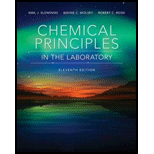
In a reaction involving the iodination of acetone, the following volumes were used to make up the reaction mixture:
a. How many moles of acetone were in the reaction mixture? Recall that, for a component A, moles
__________ moles acetone
b. What was the molarity of acetone in the reaction mixture? The volume of the mixture was 50 mL, 0.050 L, and the number of moles of acetone was found in Part (a). Again,
__________ M acetone
c. How could you double the molarity of the acetone in the reaction mixture, keeping the total volume at 50 mL and keeping the same concentrations of
(a)
Interpretation:
The reaction of iodination of acetone, forms a reaction mixture;
The moles of acetone are present in the reaction mixture should be determined.
Concept Introduction:
Mole is the amount of the substance that contains the same number of particles or atoms or molecules. Molar mass is defined as an average mass of atoms present in the chemical formula. It is the sum of the atomic masses of all the atoms present in the chemical formula of any compound.
Answer to Problem 1ASA
Moles of acetone = 0.02 mol
Explanation of Solution
Given information:
Molarity of acetone = 4 M
Molarity of HCl = 1M
Molarity of I2 = 0.0050 M
Volume of acetone = 5 mL
Volume of HCl = 10 mL
Volume of I2 = 10 mL
Volume of H2O = 25 mL
The calculation of moles of acetone is shown below:
(b)
Interpretation:
The reaction of iodination of acetone, forms a reaction mixture;
The molarity of acetone in the reaction mixture should be determined when volume of mixture is 50 mL
Concept Introduction:
Mole is the amount of the substance that contains the same number of particles or atoms or molecules. Molar mass is defined as an average mass of atoms present in the chemical formula. It is the sum of the atomic masses of all the atoms present in the chemical formula of any compound.
The ratio of moles to the volume in liters is known as molarity.
Answer to Problem 1ASA
Molarity of acetone = 0.4 M
Explanation of Solution
Given information:
Molarity of acetone = 4 M
Molarity of HCl = 1M
Molarity of I2 = 0.0050 M
Volume of acetone = 5 mL
Volume of HCl = 10 mL
Volume of I2 = 10 mL
Volume of H2O = 25 mL
The calculation of molarity of acetone is shown below:
(c)
Interpretation:
The reaction of iodination of acetone, forms a reaction mixture;
Keeping the total volume and concentration of H+ and I2 remains same; predict how the molarity of aceteone should be doubled.
Concept Introduction:
Mole is the amount of the substance that contains the same number of particles or atoms or molecules. Molar mass is defined as an average mass of atoms present in the chemical formula. It is the sum of the atomic masses of all the atoms present in the chemical formula of any compound.
Answer to Problem 1ASA
Explanation of Solution
If concentration of H+ and I2 remains the same then decreases the volume of H2O by 15 mL and increases the initial concentration of acetone with volume by 15 mL.
Want to see more full solutions like this?
Chapter 20 Solutions
Chemical Principles in the Laboratory
- Name the following molecules with IUpacarrow_forwardWhat is the molecular orbital for cyclopropenyl anion and is it aromatic, antiaromatic or nonaromatic?arrow_forwardUsing the chart describe the change from cystine to tyrosine and its impact on the protein. Using the chart describe the change from histidine to aspartic acid and its impact on the protein.arrow_forward
- How to get the predicted product of this reaction belowarrow_forwardPlease help me fill out the chart then using the chart describe the change from cystine to tyrosine and its impact on the protein. Then using the chart describe the change from histidine to aspartic acid.arrow_forwardWrite the Esterification reaction mechanism for acetic acid, and one propanol to make propanol ethanoate (molecule that gives peas its odor in flavor)arrow_forward
 Chemistry: The Molecular ScienceChemistryISBN:9781285199047Author:John W. Moore, Conrad L. StanitskiPublisher:Cengage Learning
Chemistry: The Molecular ScienceChemistryISBN:9781285199047Author:John W. Moore, Conrad L. StanitskiPublisher:Cengage Learning Chemistry: Principles and PracticeChemistryISBN:9780534420123Author:Daniel L. Reger, Scott R. Goode, David W. Ball, Edward MercerPublisher:Cengage Learning
Chemistry: Principles and PracticeChemistryISBN:9780534420123Author:Daniel L. Reger, Scott R. Goode, David W. Ball, Edward MercerPublisher:Cengage Learning Chemistry & Chemical ReactivityChemistryISBN:9781337399074Author:John C. Kotz, Paul M. Treichel, John Townsend, David TreichelPublisher:Cengage Learning
Chemistry & Chemical ReactivityChemistryISBN:9781337399074Author:John C. Kotz, Paul M. Treichel, John Townsend, David TreichelPublisher:Cengage Learning Chemistry & Chemical ReactivityChemistryISBN:9781133949640Author:John C. Kotz, Paul M. Treichel, John Townsend, David TreichelPublisher:Cengage Learning
Chemistry & Chemical ReactivityChemistryISBN:9781133949640Author:John C. Kotz, Paul M. Treichel, John Townsend, David TreichelPublisher:Cengage Learning



